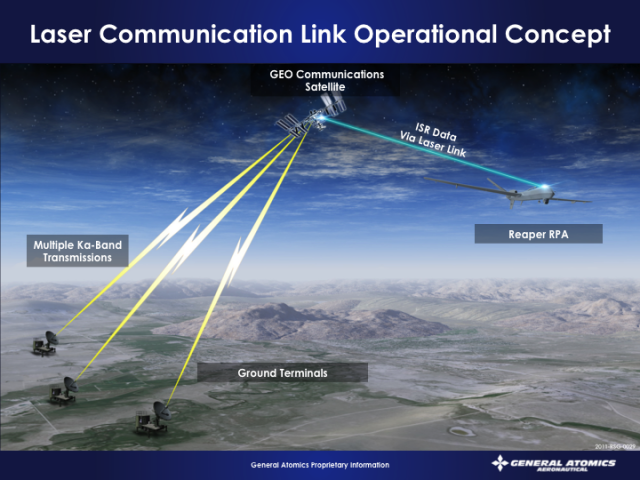 General Atomics Aeronautical Systems, Inc. and Tesat-Spacecom announced that they have signed a teaming agreement to combine their expertise in the field of RPA laser communication (lasercom) to demonstrate a high-rate RPA-to-spacecraft lasercom link.
General Atomics Aeronautical Systems, Inc. and Tesat-Spacecom announced that they have signed a teaming agreement to combine their expertise in the field of RPA laser communication (lasercom) to demonstrate a high-rate RPA-to-spacecraft lasercom link.
“New sensors and increased RPA usage will create an increased bandwidth demand for RPA-to-ground communication in the near future, exceeding currently installed RF [Radio Frequency] communication capabilities,” said Linden Blue, president, Reconnaissance Systems Group, GA-ASI. “With the potential to increase data rates by 1,000 times, a lasercom link offers a next-generation alternative to radio Satcom [Satellite communications], and Tesat’s involvement with the U.S.-German programme that has validated space-to-space and space-to-ground laser data links at very high data rates makes them the ideal partner for this new venture.”
Today’s RPA rely on RF links to transmit sensor data from an RPA. A high-bandwidth optical link between an above-the-weather RPA and a GEO satellite offers a secure, jamming-resistant, alternative to Ku- and Ka-Band data links.
“LaserCom enables the capability to integrate air- and space-based wideband Intelligence, Surveillance and Reconnaissance [ISR] systems into national command and control systems in a way that was previously not possible,” said Peter Schlote, CEO of Tesat-Spacecom GMBH & Co. KG.
Under the agreement, GA-ASI will solicit government support to demonstrate an optical laser subsystem. Tesat’s role will be to support the Laser Communication Terminal (LCT) systems engineering and deliver a data link controller to handle the data transfer between the RPA and a communication satellite.
Following development, the team plans to demonstrate the capabilities of the lasercom system via a 2.6 GB/sec uplink to an available Low Earth Orbit (LEO) spacecraft. The follow-on prototype will use the Alphasat satellite’s Alphabus LCT in a geo-stationary orbit, verifying a high-bandwidth, RPA-to-ground data capability.
Source: Press Release
